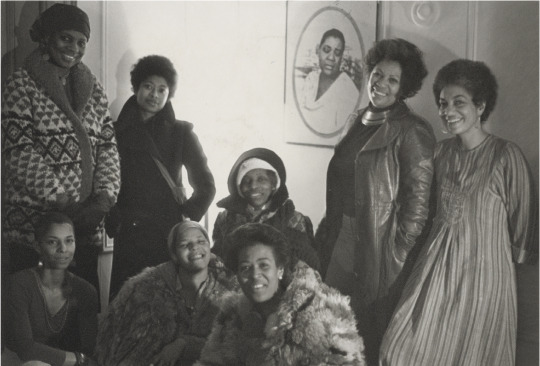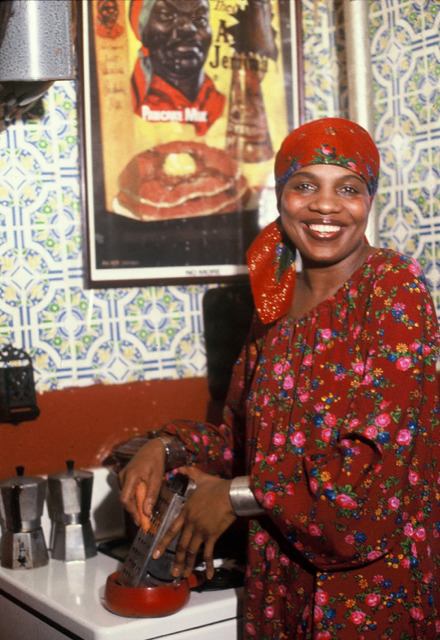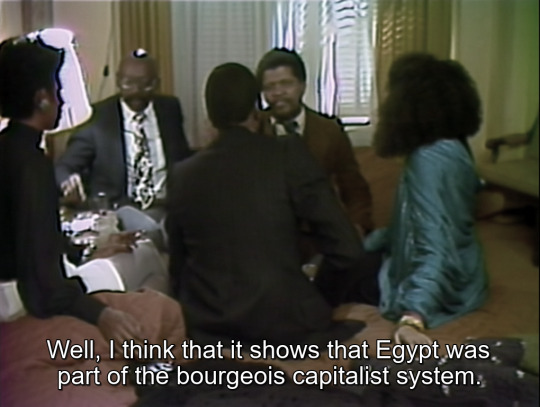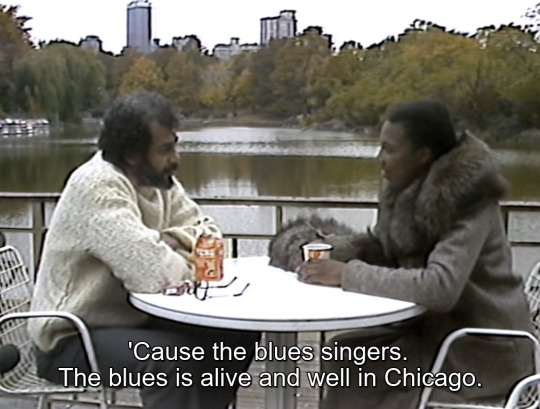#vertamae smart-grosvenor
Explore tagged Tumblr posts
Photo

For the past few years, a photograph has circulated on social media of a Black women’s writing group from the 1970s called the Sisterhood. Pictured are the writers Nana Maynard, Ntozake Shange, Louise Meriwether, Vertamae Smart-Grosvenor, Alice Walker, Audrey Edwards, June Jordan, and Toni Morrison—all the current patron saints of literary culture, before they were anointed, when they were working artists.
“They weren’t brands, and they weren’t celebrities.”
#chromatic voice#nana maynard#ntozake shange#louise meriwether#vertamae smart-grosvenor#alice walker#audrey edwards#june jordan#toni morrison
1K notes
·
View notes
Text






Personal Problems, Bill Gunn (1980)
7 notes
·
View notes
Text
0 notes
Text
0 notes
Text










"To limit her to soul food is to say that all black music is blues, and to dismiss gospel and jazz. It's essentializing her work."
0 notes
Text

Vertamae Smart-Grosvenor (April 4, 1937 – September 3, 2016) was a culinary anthropologist, griot, food writer, and broadcaster on public media. Born into a Gullah family in the Low Country of South Carolina, she moved with them as a child to Philadelphia during the Great Migration. She lived in Paris before settling in New York City. She was active in the Black Arts Movement and performed on Broadway.
Her travels informed her of cooking and the appreciation of food as a culture. She was known for her cookbook memoir, Vibration Cooking: or, The Travel Notes of a Geechee Girl, and published numerous essays and articles. She produced two award-winning documentaries and was a commentator for years on NPR, serving as a contributor to its NOW series.
She appeared in several films, including Daughters of the Dust and Beloved. She was in a National Geographic documentary about the Gullah people.
She married Bob Grosvenor and they had a daughter, Kali Grosvenor, and separated. Kali Grosvenor-Henry is married and a poet, essayist, and author. She and Kali published for the first time simultaneously: In 1969, a Doubleday employee received Kali’s poetry manuscript and her cookbook notes and decided to publish both pieces. The following year, in 1970, when Kali was nine, Doubleday published both Poems by Kaliand Vibration Cooking.
In 1962, had her daughter Chandra Ursule Weinland-Brown, who is married and an actor, visual artist, and poet. She had this child with Oscar Weinland. #africanhistory365 #africanexcellence
1 note
·
View note
Photo

Truly astounding photograph
(front row from left) Nana Maynard, Ntozake Shange, Louise Meriwether
(back row from left) Vertamae Smart-Grosvenor, Alice Walker, Audrey Edwards, Toni Morrison and June Jordan
Photo of Bessie Smith in the background
The Sisterhood Members, 1977, Alice Walker papers
#the sisterhood#alice walker papers#black women writers#nana maynard#ntozake shange#louise meriwether#vertamae smart-grosvenor#alice walker#audrey edwards#toni morrison#june jordan#bessie smith
291 notes
·
View notes
Photo

Members of The Sisterhood, 1977, a writing collective/circle founded by Alice Walker and June Jordan in NYC. Front row, left to right: Nana Maynard, Ntozake Shange, Louise Meriwether; back row, left to right: Vertamae Smart-Grosvenor, Alice Walker, Audrey Edwards, Toni Morrison and June Jordan. abladeofgrass.org
(via "Calling All Grand Mothers" :: The Grandmother Project)
25 notes
·
View notes
Text
2 notes
·
View notes
Link
Julie got a grant from the NEH to complete Travel Notes of a Geechee Girl!!!!!!
127 notes
·
View notes
Text
1 note
·
View note
Text


Personal Problems, Bill Gunn (1980)
#bill gunn#vertamae smart-grosvenor#robert polidori#walter cotton#ishmael reed#definitely a candidate for best US film of the 1980s
3 notes
·
View notes
Text
Download PDF Vibration Cooking: or, The Travel Notes of a Geechee Girl EBOOK -- Vertamae Smart-Grosvenor
Download Or Read PDF Vibration Cooking: or, The Travel Notes of a Geechee Girl - Vertamae Smart-Grosvenor Free Full Pages Online With Audiobook.

[*] Download PDF Here => Vibration Cooking: or, The Travel Notes of a Geechee Girl
[*] Read PDF Here => Vibration Cooking: or, The Travel Notes of a Geechee Girl
0 notes
Text
Thoughts : Personal Problems (1980)

Discovering a new director can often lead to awareness of a wealth of content. While recently diving into Bill Gunn, the diversity of his work really stood out to me, and the one piece that specifically caught my attention was his self-described ‘meta soap opera’, the sprawling and heavily dramatic Personal Problems.
Johnnie Mae Brown (Vertamae Smart-Grosvenor) is a nurse living in Harlem who is in the depths of an unhappy relationship with her husband Charles Brown (Walter Cotton). After long, stressful days, she comes home to an unhappy Charles, a small apartment, and an unwanted houseguest in the form of Father Brown (Jim Wright), her hard luck stepfather. Her problems multiply when her stepbrother Bubba (Thommie Blackwell) and his wife Mary Alice (Andrea W. Hunt) migrate to New York from California to escape and repair their own troubled past. With Charles being openly unfaithful to her, Johnnie Mae seeks out her own side romance in the form of Raymon (Sam Waymon), a local musician, but like most things in her life, she finds herself unsatisfied and unfulfilled. Just as Johnnie Mae is reaching her breaking point, Father Brown dies, which brings Charles’ family into the mix to confront Johnnie Mae and force her to face her reality.
The format of this film is very forward-thinking... even though An American Family and Scenes from a Marriage were both already in existence (and both released coincidentally in 1973), the “reality-based” storytelling device was still not a common one used in mass media outside of news or documentaries. The use of this format allowed the characters, specifically the character of Johnnie Mae Brown, to provide additional insight and context to the events of the film without the need for clunky exposition dumps to set up the interpersonal conflicts, which in turn allows the actors to reach their desired emotional levels more directly and in a more believable fashion. Specifically, the interviews provide subtext that would be impossible to get without the aforementioned exposition dumps, like the recollections of Johnnie Mae’s mother working as a housecleaner only to come home and vent her frustrations about having to clean more house, and how this is later mirrored in Johnnie Mae’s frustrations with her encumbering houseguests. In turn, the moments between Johnnie Mae and Raymon are given room to develop their own arc, rather than serving a secondary function for Johnnie Mae to voice said subtext.
With the use of this reality-driven format, the experimentation comes into play during the middle act of the film, where we are given a presentation of previously witnessed events as if they occur over a matter of weekdays. This breaking of the linear narrative not only drives home how mundane life has gotten for all parties involved in the echoing montage, but the reoccurrence of singular identical issues and conflicts drives home Johnnie Mae’s frustration and pain in the face of these expected issues and conflicts. Act three further breaks the format by adding the dramatic catalyst of Father Brown’s death, which brings out the most extreme versions of all characters involved as they face an inquisition from those attending Father Brown’s funeral. The tension reaches breaking points all around, which is a needed breakdown in order for all parties involved to build back up their fractured relationships. It is this blurring of the lines of reality in tandem with the extremely relatable drama that brings out the soap opera aspects of the project.
Video used in a motion picture format is definitely jarring at first, as motion blur and RGB split tend to be present, but at a certain point either the technology improved or my eyes got used to it, because the images improved. The freedom that video provided the cinematography allows more variety in the setups, which I am sure allowed the actors to stay at the volatile and energetic levels they present on the screen. It is quite impressive that the film was able to be cut together like a traditional film, as most use of video tends to result in limited coverage or cutting corners... this high quality of editing in contrast with the lower quality of video creates an uncanny valley experience in terms of how the viewer takes in the information presented, which almost forces them to hang on to the emotion and drama doled out by the actors. Casting Sam Waymon was a benefit in terms of soundtracking, as he is able to provide palatable in-world music to contrast the traditional scoring of Carman Moore.
Vertamae Smart-Grosvenor channels frustration, tenderness, aspirations, confusion and fierceness, among other emotions, into a highly tuned and laser-focused performance of a woman on the edge of lashing back out at the aspects of life that cause her pain. Walter Cotton plays as withdrawn and scorned as a compliment to Smart-Grosvenor’s performance, playing down when around her and allowing his brightness to shine among others to a highly effective degree. Sam Waymon is captivating in his talent and charisma, but eventually exudes equal detachment to that of Cotton, albeit it in a much more social manner, but with the lack of attention to Smart-Grosvenor translating all the same. Jim Wright attempts to bring a bit of levity and ‘salt of the Earth’ quality to the mix, while wonderfully twisting Smart-Grosvenor’s nerve. Thommie Blackwell and Andrea W. Hunt also bring comic energy into the mix, though Hunt does begin to evolve prior to their swift removal from the story. Supporting roles are filled in by Ishmael Reed (who developed the concept and initially wrote the film), Kip Hanrahan, Michele Wallace, Mizan Nunes, Alan Beckles, Margo Williams and many more.
While I’ve never had the courage to truly dabble in experimental filmmaking myself, I do appreciate it when it’s done by others, especially when it is done well. It has become crystal clear to me that Bill Gunn is an under-recognized genius with extremely forward-thinking sensibilities, and if asked to back up these thoughts, I know that I can easily point to Personal Problems as validation of these statements.
#ChiefDoomsday#DOOMonFILM#BillGunn#PersonalProblems#VertamaeSmart-Grosvenor#WalterCotton#SamWaymon#JimWright#ThommieBlackwell#AndreaWHunt#IshmaelReed#KipHanrahan#MicheleWallace#MizanNunes#AlanBeckles#MargoWilliams#CarmanMoore
1 note
·
View note
Text
Heirloom Tomatoes + Grilled Corn Mayo
For the grilled corn mayonnaise: start your charcoal grill—charcoal bears repeating, gas just doesn’t do it for me—until it’s hot, shuck 4 ears of corn, and grill the corn until it's cooked, even blackened in spots. Remove the kernels to a food processor and blitz the corn with
2 egg yolks;
1 garlic clove;
1/4 cup lemon juice;
1 teaspoon Dijon mustard;
1 teaspoon honey;
1/4 teaspoon cayenne pepper; and
1 teaspoon salt.
With the blade running, very slowly pour in 1 cup sunflower oil until emulsified. Refrigerate until needed.
To assemble the open-faced sandwich, lightly toast several slices of sourdough bread—basically dried out just enough to absorb the tomato juices—slather with mayonnaise, top with slices of cherokee green heirloom tomatoes, and sprinkle with salt. Enjoy.
Let’s imagine for a minute that you’ve had your fill of tomato sandwiches—I have yet to feel this sentiment, but I have run out of tomatoes mid-week—and have extra mayonnaise hanging around:
Crab Salad
Mix together
2 cups lump crab meat;
1/4 cup grilled corn mayonnaise;
3 tablespoons red bell pepper, finely chopped;
2 tablespoons shallot, finely chopped;
1 tablespoon celery, finely chopped;
1/4 teaspoon cayenne pepper; and
salt, to taste.
The salad can be eaten immediately, but for better results refrigerate it for a couple hours to gather its flavors. Eat with saltine crackers—avoid any temptation to use a fancier cracker.
Note: The corn mayonnaise recipe is adapted from Vivian Howard’s Deep Run Roots and the crab salad is adapted from Vertamae Smart-Grosvenor's Vibration Cooking: Or, the Travel Notes of a Geechee Girl.
0 notes
Photo

Vertamae Smart-Grosvenor (April 4, 1937 – September 3, 2016) was a culinary anthropologist, griot, food writer, and broadcaster on public media. Born into a Gullah family in the Low Country of South Carolina, she moved with them as a child to Philadelphia during the Great Migration. She lived in Paris before settling in New York City. She was active in the Black Arts Movement and performed on Broadway. Her travels informed her cooking and appreciation of food as a culture. She was known for her cookbook memoir, Vibration Cooking: or, The Travel Notes of a Geechee Girl, and published numerous essays and articles. She produced two award-winning documentaries and was a commentator for years on NPR, serving as a contributor to its NOW series. She appeared in several films, including Daughters of the Dust and Beloved. She was in a National Geographic documentary about the Gullah people. #africanhistory365 #africanexcellence https://www.instagram.com/p/Cb7acKdLvizZzuJDSpjx3HwwUuIbOpkv-Y61rE0/?utm_medium=tumblr
0 notes